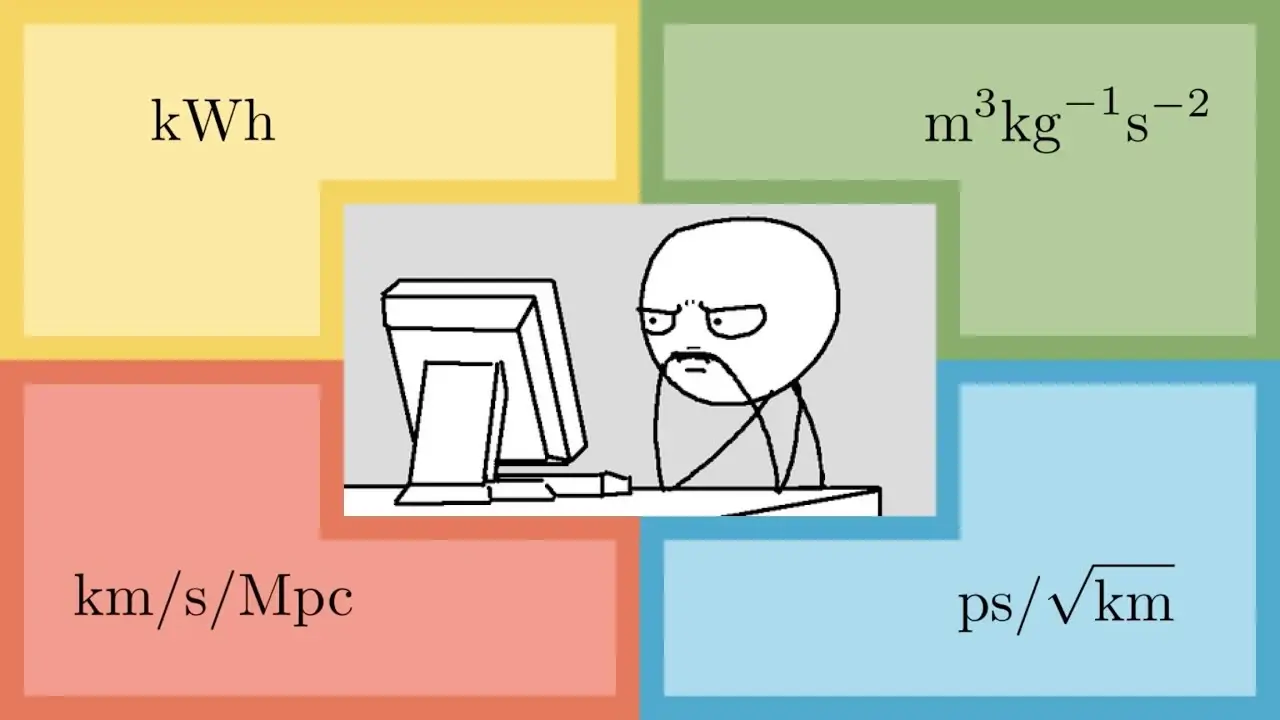A way that I’ve found to avoid “cursing” units is to always include what they refer to, into the equations. A good example of that is concentration per weight:
- not including it - “brine is 28% g/g” → “brine is 28%, unitless” → “brine is 28%… uh… was I measuring it through volume, weight, or molarity?”
- including it - “brine is 28% (g solute)/(g solution)” (and you can’t cancel the units out as they’re different.)
This solves a lot of cursed examples from the video:
- fuel economy - you can list it in (L fuel)/(km road), (km road)/(L fuel), or even (m³ fuel)/(m road). But you can’t really divide the later, as 1∛(m³ fuel)’ is not the same as 1(m road).
- km/s/Mpc - 1 Hz is not just 1/s, but rather (1 event)/s. So unless you’re dealing with the time between events, you don’t use Hz, period; at most s⁻¹
IMO kWh=k(J/s)*h is silly though. It would be simpler if power was listed in MJ/h, and then consumption in MJ; sticking to simpler units whenever possible.
The one for dispersion feels fishy; is dispersion really expected to be measured by the square root of length?
The one for dispersion feels fishy; is dispersion really expected to be measured by the square root of length?
Yeah that’s a pretty standard way to do things for all kinds of random walk processes. You don’t pick up error at a constant rate with distance, as you can go either forward or backward and will often be undoing dispersion you’ve already accumulated. The most likely outcome after any distance is always for you to be exactly back where you started. However, as stated in the video, the expectation value of the root-mean-square distance from the origin (i.e. how far from the origin do you end up on average) for a random walker after N steps is the square root of N. There’s a quite good explanation on this page.
If you really dislike having the square root in there you can of course square everything to get rid of it, but at the cost of your other dimension being squared. I’d personally argue that it’s a lot easier to get a physical intuition from the ps/sqrt(km) units (you can expect to pick up dispersion proportional to the square root of the length of your fiber) than from ps^2/km (which to me just looks like inverse acceleration). The latter is valid though. In fact, if you type that into Wolfram it’ll tell you that those units are physically interpretable as the “group velocity dispersion with respect to angular frequency”!
A way that I’ve found to avoid “cursing” units is to always include what they refer to
I actually have a very neglected side project to build a little calculator app that treats units this way, where you can label them to avoid letting them cancel out. I might get some time to work on it in like a month? Or maybe I won’t get around to it until after I graduate, we’ll see 🙃
The one for dispersion feels fishy; is dispersion really expected to be measured by the square root of length?
Yes, because dispersion of the type discussed is fundamentally not a linear phenomenon. Dispersion at 1km is about half of the dispersion at 4km and about a third of the dispersion at 9km. The only sensible way to handle it is through using sqrt(km) as a unit. The YouTube video is not the only place that uses this unit. It is featured in the Wikipedia article on polarization mode dispersion as well, and was initially added to the article in Oct 2004.
Based on yours and @realChem@beehaw.org’s replies, as well as the links that you two provided, I think that I understood 1) why there’s a cursed unit there, 2) how to uncurse it, and 3) why it’s better to just leave it cursed.
In the formula Δτ = D√L (from Wikipedia), that “√L” is just a practical hack. The time differential doesn’t depend on the square root of the length itself, but of the number of events causing the light to disperse. Number of events is unitless, so is its square root.
So physics-wise a more accurate formula would be Δτ = k√E; where
- k = some constant; probably universal??? measured in an unit of time (ps is fine)
- E = number of events causing the diffraction
In turn, you can measure the number of events as the product of a parameter and length, like E=NL:
- N = a parameter of the fibre, proportional to the concentration of junk and irregularities forcing diffraction, in km⁻¹ (or any the inverse of any other unit of length)
- L = the actual length of the fibre
Feeding this back into the equation, you get Δτ = k√E → Δτ = k√(NL). You can expand the square root there to get Δτ = k√N√L if you want; and then with k√N = D, you’re back to the old formula - including the cursed ps/√km unit. And that shows why the practical hack is there on first place: why would you keep track of a constant and a parameter, if just a parameter is enough?
(By the way, thanks to both of you for your explanations.)
You can also express the consumption of a BEV (typically in kWh/100km or Wh/km) in Newton (N), which is a unit of force.






